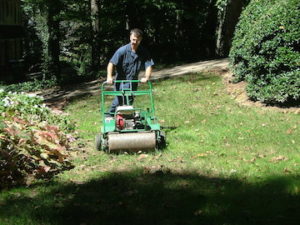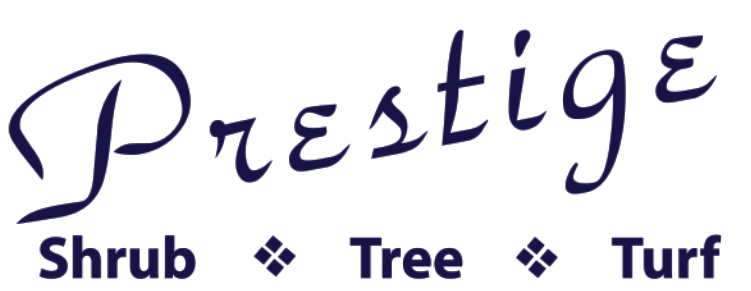 Though the fescue turf always moves into the summer lush and thick, it is a given that by the end of summer the heat and disease will have thinned the turf to the point that reseeding is required. Because of the normal compaction of the soil by foot and lawn mower traffic aeration is also required. Though the seeds do germinate more quickly in the aeration holes, aeration’s main purpose is to reduce soil compaction and increase nutrient, water and air movement into the ground. Because of our heavy clay soil, root systems rarely penetrate more than 3″ – 4″ deep, thus core aerators with these tine lengths are adequate for the aeration process. You won’t always see the entire length of the plug left on the soil surface after aeration since, in most cases, the plug partially crumbles as it hits the ground.
Though the fescue turf always moves into the summer lush and thick, it is a given that by the end of summer the heat and disease will have thinned the turf to the point that reseeding is required. Because of the normal compaction of the soil by foot and lawn mower traffic aeration is also required. Though the seeds do germinate more quickly in the aeration holes, aeration’s main purpose is to reduce soil compaction and increase nutrient, water and air movement into the ground. Because of our heavy clay soil, root systems rarely penetrate more than 3″ – 4″ deep, thus core aerators with these tine lengths are adequate for the aeration process. You won’t always see the entire length of the plug left on the soil surface after aeration since, in most cases, the plug partially crumbles as it hits the ground.
If you are doing your own aerating and seeding:
-
Be sure to use a quality, hybrid turf type tall fescue. Blends of these hybrid, turf type fescues are fine (and in some cases superior to single variety types) but DO NOT use mixes with grasses such as Chewings fescue, red fescue or blue grass. We also do not recommend “Heat Tolerant Blue” blue grass for our area.
-
On the seed tag, germination should be at least 90%, purity in excess of 90% and the “Other” (noxious weeds) should be less than 1%. These are ideal numbers and you may have to settle for something slightly less. Also check the date to be sure the seed is not over a year old.
-
Prior to overseeding mow the fescue to 2½”. This will help the seed reach the soil without stressing the current stand.
-
Always use a core aerator not a spike type or slit type.
-
High quality seed is expensive. If you find a exceptionally low price way out of line with other prices then look closely to determine the reason. A deal is not always a deal.
-
The seeding rate for overseeding existing fescue lawns is 5-8 #s per thousand square feet. Thicker turf uses the lower rate, thinner turf requires the higher rate. Bare areas require 10#s. DO NOT increase these seeding rates or you greatly increase the chances for disease incidence because of excessive turf density. It may look great now but there will be pay back!
-
Keep the seed bed moist until germination. After germination occurs, water 1-1½” per week, but not until the turf is sloppy wet.
-
Do not mow the new grass until it is 3″ tall. Then maintain at a height of 3″. If the turf is not growing then DON’T mow. Don’t mow just to pick up fall leaves; blow instead!
